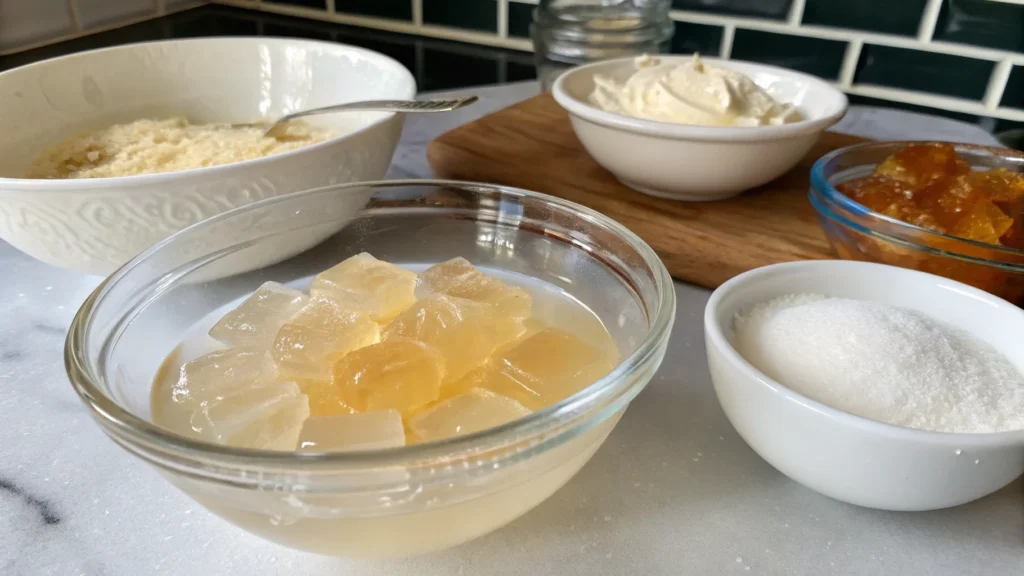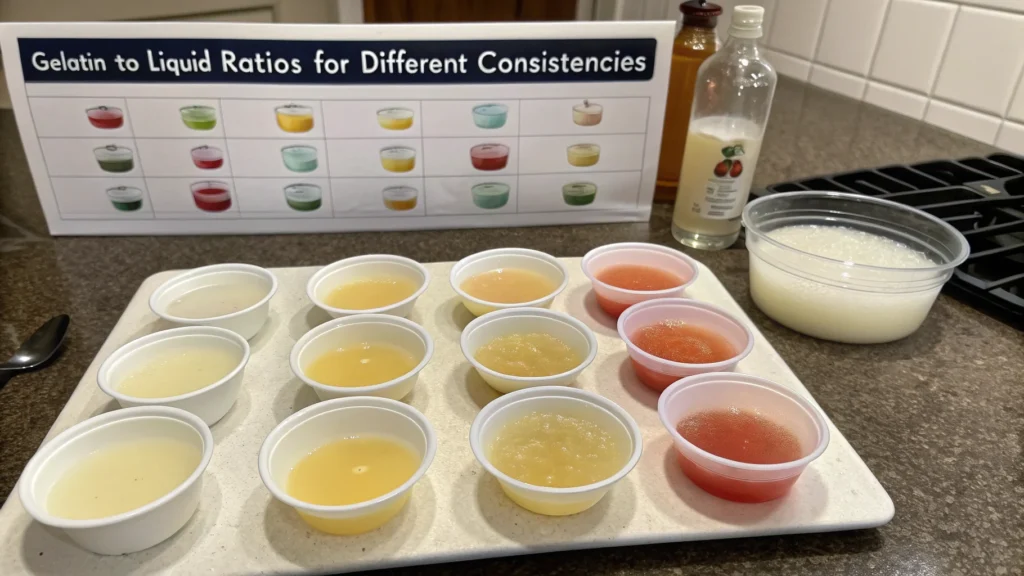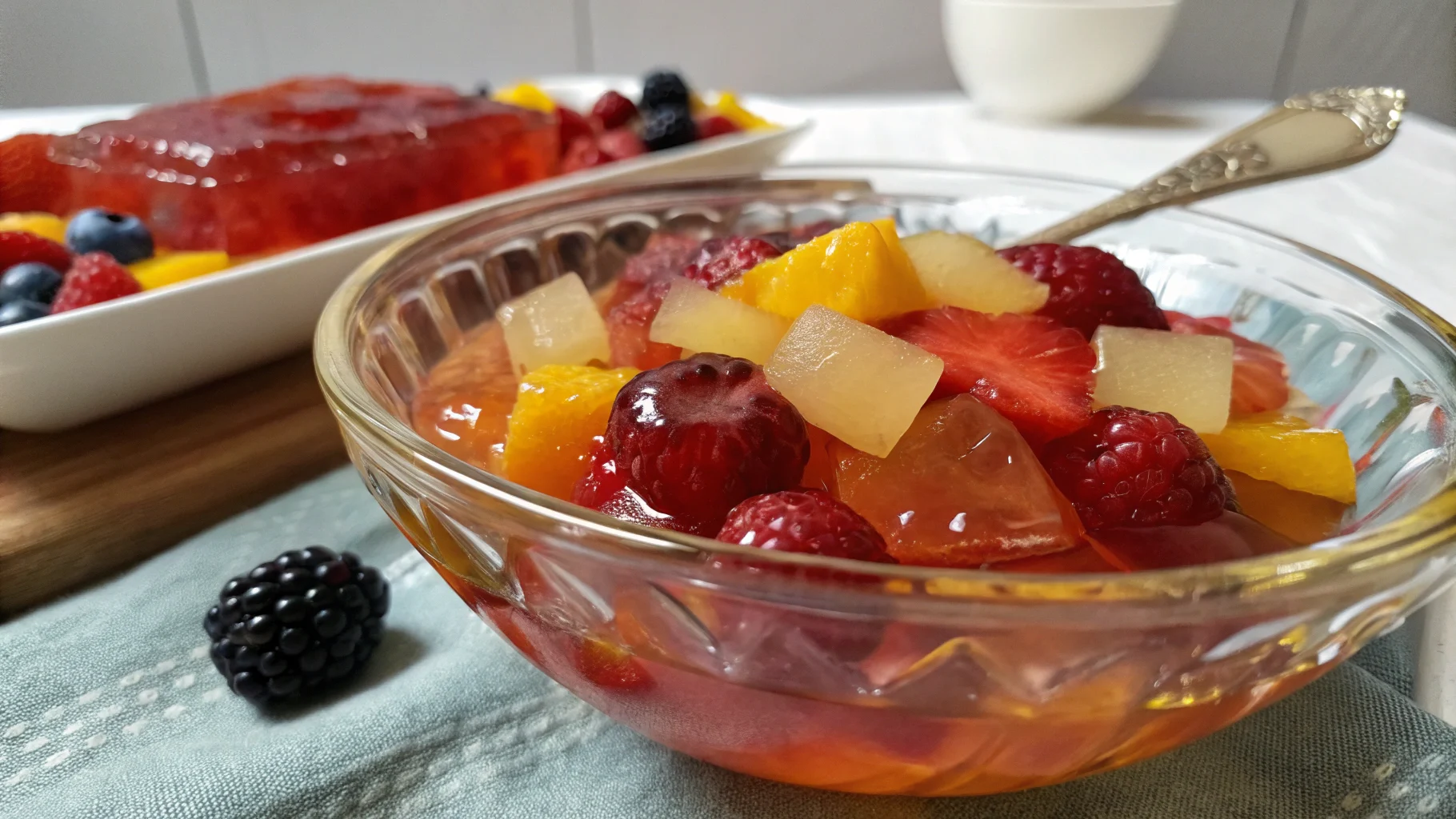Gelatin plays a crucial role in thickening and setting fruit puree, transforming it into a firm yet smooth texture ideal for desserts, fillings, and toppings. Understanding how gelatin works and why it’s a preferred thickening agent helps ensure perfect results every time.
Table of Contents
What is Gelatin and How Does It Work?
Gelatin is a protein derived from collagen, commonly sourced from animal bones and connective tissues. When mixed with liquid and heated, it dissolves and forms a network of protein strands. As the mixture cools, these strands create a gel-like structure that traps liquid, giving the dish a semi-solid consistency.
The process of using gelatin involves three key steps:
- Blooming – Gelatin is first sprinkled over a small amount of cold liquid to soften and expand.
- Dissolving – The bloomed gelatin is then gently heated until fully dissolved.
- Setting – Once combined with the fruit puree, the mixture is chilled to allow the gelatin to firm up.
This gelling process is reversible—if heated again, gelatin melts back into a liquid state, making it versatile for various recipes.
Why Use Gelatin for Fruit Puree?
Gelatin is an excellent choice for setting fruit puree due to its neutral taste, smooth texture, and ability to enhance stability in desserts. Here’s why it’s widely used:
- Creates a soft, smooth gel – Perfect for mousses, jellies, and fruit-based fillings.
- Enhances structure – Helps fruit puree hold its shape without becoming too runny.
- Maintains fresh fruit flavor – Unlike other thickeners, gelatin does not alter the taste.
- Adds a light, bouncy texture – Ideal for creating delicate yet firm fruit-based dishes.
By understanding gelatin’s function, you can confidently use it to achieve the perfect texture in fruit purees, ensuring a stable and visually appealing final product.

How Much Gelatin to Set Fruit Puree?
Using the right amount of gelatin is essential to achieving the perfect texture in fruit puree. Adding too little may result in a runny consistency, while too much can make it overly firm or rubbery. Below, we’ll cover the standard gelatin-to-liquid ratio and the factors that influence gelatin’s setting power.
Standard Gelatin-to-Liquid Ratio for Fruit Puree
The ideal gelatin-to-liquid ratio depends on the desired consistency of the fruit puree. Here’s a general guideline for unflavored powdered gelatin:
| Desired Texture | Gelatin Amount (per 1 cup / 240ml of fruit puree) |
|---|---|
| Soft Set (Jelly-Like) | 1 teaspoon (about 2.5g) |
| Medium Set (Custard-Like) | 1.5 teaspoons (about 3.7g) |
| Firm Set (Sliceable) | 2 teaspoons (about 5g) |
For gelatin sheets, the equivalent measurement is:
- 1 powdered gelatin teaspoon ≈ 2 gelatin sheets
Since gelatin’s strength can vary by brand, always check packaging instructions to ensure the correct amount.
Factors Affecting Gelatin Strength
Several factors can impact how well gelatin sets fruit puree:
- Acidity of the Fruit
- Highly acidic fruits like pineapple, kiwi, mango, and papaya contain enzymes that break down gelatin, preventing it from setting properly.
- Solution: Heat the fruit puree before adding gelatin to deactivate these enzymes.
- Sugar Content
- High sugar levels can weaken gelatin’s structure. If using a very sweet fruit puree, you may need to slightly increase the gelatin amount.
- Temperature & Cooling Time
- Gelatin must be cooled gradually (ideally in the fridge) for a minimum of 4 hours to achieve a firm set.
- Freezing is not recommended as it can break the gel structure.
- Type of Gelatin Used
- Powdered gelatin, gelatin sheets, and vegetarian alternatives (like agar-agar) have different setting strengths and should be measured accordingly.
By following these guidelines, you can ensure your fruit puree sets to the perfect consistency every time!
How to Thicken Fruit Puree with Gelatin?

Gelatin is an easy and effective way to thicken fruit puree, giving it a smooth, stable texture for use in desserts, fillings, and toppings. Below is a step-by-step guide to using gelatin properly, along with expert tips for achieving the best results.
Step-by-Step Guide to Thickening Fruit Puree
Step 1: Measure the Ingredients
- Determine the right gelatin-to-liquid ratio based on your desired consistency (see Part 2).
- Use unflavored powdered gelatin or gelatin sheets for the best results.
Step 2: Bloom the Gelatin
- Powdered Gelatin:
- Sprinkle the gelatin evenly over 2-3 tablespoons of cold water per teaspoon of gelatin.
- Let it sit for 5-10 minutes until it swells and absorbs the water.
- Gelatin Sheets:
- Soak the sheets in cold water for about 5 minutes, then gently squeeze out excess water.
Step 3: Heat the Fruit Puree
- Warm your fruit puree over low heat until it reaches about 120°F (49°C). Do not boil, as excessive heat can weaken the gelatin.
Step 4: Dissolve the Gelatin
- Add the bloomed gelatin to the warm fruit puree, stirring constantly until fully dissolved.
- Ensure there are no lumps before proceeding.
Step 5: Cool and Set
- Pour the mixture into your mold or serving dish.
- Refrigerate for at least 4 hours, or until fully set.
Tips for Achieving the Perfect Texture
✅ Avoid Overheating – High heat can break down gelatin, leading to a weak set. Always dissolve it in warm, not boiling liquid.
✅ Adjust for Fruit Acidity – If using acidic fruits like pineapple or kiwi, heat the puree first to neutralize enzymes that prevent setting.
✅ Strain for a Smoother Texture – If you want a silky consistency, strain the puree after dissolving the gelatin.
✅ Chill Slowly – Let the gelatin set in the fridge, not the freezer, to prevent a grainy texture.
✅ Use the Right Gelatin Type – Powdered gelatin and sheets yield different strengths, so measure accordingly.
By following these steps, your fruit puree will have the perfect consistency for any dessert!
What Is the Ratio of Gelatin to Liquid?

The correct gelatin-to-liquid ratio is key to achieving the desired consistency in fruit puree. Whether you want a soft, spoonable texture or a firm, sliceable set, adjusting the amount of gelatin is crucial. Below, we provide a conversion chart and tips for adjusting gelatin for different consistencies.
General Gelatin-to-Liquid Conversion Chart
The table below shows the recommended gelatin-to-liquid ratio for unflavored powdered gelatin in fruit puree:
| Desired Texture | Gelatin Amount (per 1 cup / 240ml of fruit puree) | Equivalent Gelatin Sheets |
|---|---|---|
| Soft Set (Spoonable) | 1 teaspoon (2.5g) | 2 sheets |
| Medium Set (Custard-Like) | 1.5 teaspoons (3.7g) | 3 sheets |
| Firm Set (Sliceable) | 2 teaspoons (5g) | 4 sheets |
| Extra Firm (Jelly Candy) | 3 teaspoons (7.5g) | 5 sheets |
💡 Note: If using gelatin sheets, use gold-strength sheets (200 bloom) for best results.
Adjusting Gelatin Amount for Different Consistencies
- For a Softer Texture:
- Reduce the gelatin slightly (e.g., from 2 teaspoons per cup to 1.5 teaspoons) to achieve a more delicate, custard-like consistency.
- Ideal for spoonable fruit sauces, mousses, or light jellies.
- For a Firmer Set:
- Increase the gelatin amount (e.g., from 1 teaspoon per cup to 2 teaspoons) for a more stable, sliceable texture.
- Great for fruit-based terrines, tarts, or molded desserts.
- For Highly Acidic Fruits (Pineapple, Kiwi, Mango):
- Increase gelatin by 10-20% to compensate for enzyme breakdown.
- Pre-cook the fruit puree before adding gelatin to deactivate enzymes.
- For Sugar-Heavy Purees:
- High sugar levels can weaken gelatin.
- Increase gelatin by 10-15% if the puree has a lot of added sugar.
By following this guide, you can confidently adjust gelatin amounts to achieve the perfect fruit puree texture for your specific recipe!
How to Calculate the Right Amount of Gelatin?
To achieve the perfect consistency in fruit puree, it’s important to calculate the right amount of gelatin. Using too little results in a runny texture, while too much creates an overly firm or rubbery consistency. Below, we provide a simple formula for determining gelatin quantity and explain how to adjust for different types of gelatin.
Simple Formula to Determine Gelatin Quantity
The general formula for using powdered gelatin in fruit puree is:
📌 Gelatin Needed (grams) = (Desired Liquid Amount in mL) × (Gelatin Ratio per 100mL)
Using the standard gelatin-to-liquid ratios, here’s how much gelatin is needed:
| Liquid Amount | Soft Set (0.8g per 100mL) | Medium Set (1.2g per 100mL) | Firm Set (1.6g per 100mL) |
|---|---|---|---|
| 100mL (≈ ½ cup) | 0.8g (~¼ tsp) | 1.2g (~⅓ tsp) | 1.6g (~½ tsp) |
| 250mL (≈ 1 cup) | 2g (~1 tsp) | 3g (~1.5 tsp) | 4g (~2 tsp) |
| 500mL (≈ 2 cups) | 4g (~2 tsp) | 6g (~3 tsp) | 8g (~4 tsp) |
💡 Tip: If unsure, start with a smaller amount and adjust as needed.
Adjusting for Different Gelatin Types (Powder vs. Sheets)
Gelatin comes in two common forms: powdered gelatin and gelatin sheets. Their setting strengths differ, so you must adjust accordingly.
Powdered Gelatin vs. Gelatin Sheets Conversion
| Powdered Gelatin | Gelatin Sheets (Gold-Strength, 200 Bloom) |
|---|---|
| 1 teaspoon (~2.5g) | 2 sheets |
| 2 teaspoons (~5g) | 4 sheets |
| 1 tablespoon (~7.5g) | 6 sheets |
How to Adjust for Gelatin Strength
- Using Higher-Bloom Gelatin (250-300 Bloom)
- Use 20-25% less gelatin, as higher bloom means stronger gelling power.
- Using Lower-Bloom Gelatin (150 Bloom)
- Increase gelatin amount by 10-15% to compensate for lower strength.
- Switching Between Powder and Sheets
- 1 teaspoon (2.5g) of powdered gelatin ≈ 2 sheets of gelatin
- Adjust based on the recipe and desired consistency.
By following these calculations, you can accurately measure gelatin for any fruit puree recipe, ensuring the perfect texture every time!
Which Two Fruits Will Not Allow Gelatin to Set?
When using gelatin to set fruit puree, some fruits can interfere with the gelling process. Pineapple and kiwi are two common fruits that prevent gelatin from setting properly. Understanding why this happens and how to prepare these fruits correctly will help you achieve the desired consistency in your fruit-based recipes.
Why Pineapple and Kiwi Prevent Gelatin from Setting
Both pineapple and kiwi contain high levels of proteolytic enzymes—natural compounds that break down proteins, including the collagen in gelatin. This prevents the formation of the protein strands needed to create a stable gel.
Enzymes That Break Down Gelatin:
- Pineapple: Contains bromelain, an enzyme that digests proteins and prevents gelatin from setting.
- Kiwi: Contains actinidin, which functions similarly to bromelain by breaking down gelatin’s structure.
Because of these enzymes, when fresh pineapple or kiwi puree is mixed with gelatin, it remains liquid instead of forming a firm gel.
How to Prepare These Fruits for Use with Gelatin
The good news is that you can still use pineapple and kiwi in gelatin-based recipes by neutralizing their enzymes. Here’s how:
1. Heat Treatment (Boiling or Microwaving)
- Heat the fruit puree to at least 160°F (71°C) for 2-3 minutes.
- This deactivates the bromelain and actinidin enzymes, allowing the gelatin to set properly.
- Let the puree cool slightly before mixing with bloomed gelatin.
2. Use Canned Pineapple or Kiwi
- Canned pineapple has already been heat-treated, meaning the bromelain is inactive.
- You can use canned fruit puree without needing to cook it further.
3. Combine with Other Fruits
- Mixing pineapple or kiwi with non-enzyme fruits (like strawberries or mangoes) can help stabilize the puree.
By using these preparation methods, you can successfully incorporate pineapple and kiwi into gelatin-based fruit purees without affecting the final texture.
Common Mistakes When Using Gelatin in Fruit Puree
Using gelatin to set fruit puree may seem simple, but small mistakes can lead to runny, rubbery, or uneven textures. To achieve the perfect consistency, it’s important to avoid these common errors.
Overheating the Gelatin
One of the biggest mistakes is exposing gelatin to high heat, which weakens its ability to form a gel.
❌ Why It’s a Problem:
- Gelatin starts to break down at temperatures above 150°F (65°C).
- Overheated gelatin loses its gelling power, resulting in a soft or runny texture.
✅ How to Avoid It:
- Dissolve bloomed gelatin in warm—not boiling—fruit puree (about 120°F (49°C)).
- Never boil gelatin, and remove the puree from heat before stirring it in.
Using Too Much or Too Little Gelatin
The right gelatin-to-liquid ratio is crucial for getting the desired texture.
❌ Too Little Gelatin:
- Leads to runny or unstable puree that doesn’t hold its shape.
- Happens when gelatin measurements aren’t precise.
❌ Too Much Gelatin:
- Creates a rubbery or overly firm texture, making the puree less pleasant to eat.
- Excess gelatin can cause a stiff, unnatural mouthfeel.
✅ How to Avoid It:
- Use the correct gelatin ratio (see Part 4 for a conversion chart).
- Adjust the amount based on fruit acidity and sugar content.
Not Blooming Gelatin Properly
Blooming is a crucial first step that hydrates gelatin and allows it to dissolve smoothly.
❌ Skipping or Rushing the Blooming Process:
- Results in lumps or uneven setting in the puree.
- Causes gelatin clumps that don’t dissolve fully, affecting texture.
✅ How to Bloom Gelatin Correctly:
- Sprinkle powdered gelatin evenly over cold water (about 2-3 tbsp per teaspoon of gelatin).
- Let it sit undisturbed for 5-10 minutes until it swells and absorbs the liquid.
- If using gelatin sheets, soak them in cold water for about 5 minutes, then squeeze out excess liquid before use.
Final Tip:
By avoiding these common mistakes, you can achieve a smooth, stable, and perfectly set fruit puree every time!
Alternative Methods to Set Fruit Puree
If you need a vegetarian or plant-based alternative to gelatin, there are two great options: agar-agar and pectin. These thickeners offer different textures and are widely used in fruit-based recipes.
Agar-Agar as a Vegetarian Substitute
What is Agar-Agar?
- A plant-based gelling agent made from red seaweed.
- Works similarly to gelatin but sets firmer and at room temperature.
How to Use It in Fruit Puree:
- Use 1 teaspoon of agar-agar powder per 1 cup (240ml) of fruit puree for a firm set.
- Unlike gelatin, agar-agar must be boiled to activate (around 185°F/85°C).
- Let the mixture cool slightly before refrigerating.
- Sets within an hour at room temperature—no need for long chilling.
✅ Best for: Jellies, fruit gummies, and firm-set desserts.
Using Pectin for a Different Texture
What is Pectin?
- A natural fiber found in fruits like apples and citrus peels.
- Unlike gelatin, pectin creates a slightly softer, jam-like consistency rather than a firm gel.
How to Use It in Fruit Puree:
- Use 1-2 teaspoons of powdered pectin per cup of fruit puree.
- Mix pectin with sugar first to prevent clumping.
- Bring the fruit puree to a gentle boil to activate the pectin.
- Cool to room temperature before chilling.
✅ Best for: Fruit spreads, sauces, and spoonable desserts.
By choosing agar-agar or pectin, you can create delicious fruit-based treats without using gelatin while achieving the right consistency for your recipe!
FAQs:
When working with gelatin and fruit puree, you may encounter issues with texture, setting time, or ingredient substitutions. Below are answers to the most frequently asked questions to help you achieve the perfect consistency.
How to Fix Runny Fruit Puree After Adding Gelatin?
If your fruit puree remains runny after adding gelatin, it may be due to an incorrect gelatin ratio, insufficient cooling time, or fruit acidity. Here’s how to fix it:
✅ Check the Cooling Time
Gelatin requires at least 4 hours in the fridge to set fully.
If it’s still runny, chill for another 2-3 hours before making adjustments.
✅ Reheat and Add More Gelatin
If the puree doesn’t set after chilling, dissolve ½ teaspoon of gelatin in warm water, then stir it into the puree.
Reheat the mixture gently (do not boil) until the gelatin dissolves.
Let it cool before refrigerating again.
✅ Check for Enzyme-Rich Fruits
Fruits like pineapple, kiwi, mango, and papaya contain enzymes that prevent setting.
Boil the puree briefly before adding gelatin to deactivate these enzymes.
Can I Use Flavored Gelatin Instead of Unflavored?
Yes, but with some considerations:
✔️ Flavored gelatin (like Jell-O) already contains sugar and artificial flavors, which may alter the taste of your fruit puree.
✔️ It also has a pre-measured amount of gelatin, so it may not provide the right setting strength.
✔️ If using flavored gelatin, reduce any added sugar in your recipe to balance sweetness.
For better control over flavor and consistency, unflavored gelatin is recommended.
How Long Does It Take for Gelatin to Set Fruit Puree?
✔️ Initial setting time: 30-60 minutes at room temperature.
✔️ Full setting time: At least 4 hours in the refrigerator (for a firm texture).
✔️ Best results: Chill overnight for a fully stable and firm set.
🚫 Avoid freezing gelatin-based fruit puree, as it can become grainy and lose its smooth texture.
By following these guidelines, you can troubleshoot issues and achieve the perfect consistency in your fruit puree!
Conclusion
Using gelatin to set fruit puree is a simple yet precise process that requires the right ratios, techniques, and ingredients. By following the correct gelatin-to-liquid ratio, properly blooming and dissolving gelatin, and understanding how fruit acidity affects setting, you can achieve a smooth, stable, and perfectly set fruit puree every time.
Key takeaways from this guide:
✅ Use the correct gelatin ratio based on the desired consistency (soft, medium, or firm).
✅ Avoid overheating gelatin, as it weakens its gelling ability.
✅ Properly bloom gelatin before dissolving it in warm liquid.
✅ If using pineapple or kiwi, heat the fruit puree first to deactivate enzymes that prevent setting.
✅ Allow gelatin-based puree to chill for at least 4 hours for a firm set.
✅ Consider agar-agar or pectin as alternatives for vegetarian or different-texture needs.
Whether you’re making fruit jellies, mousses, tarts, or fillings, mastering these techniques ensures that your fruit puree will always set to perfection. Experiment with different textures and fruits to create delicious and visually stunning desserts!
Now that you know how to thicken fruit puree with gelatin, why not try incorporating it into your favorite recipes? Happy cooking!
How to Make Fruit Gelatine Recipe: Easy & Creative Ideas
My Facebook Eminent Recipes

